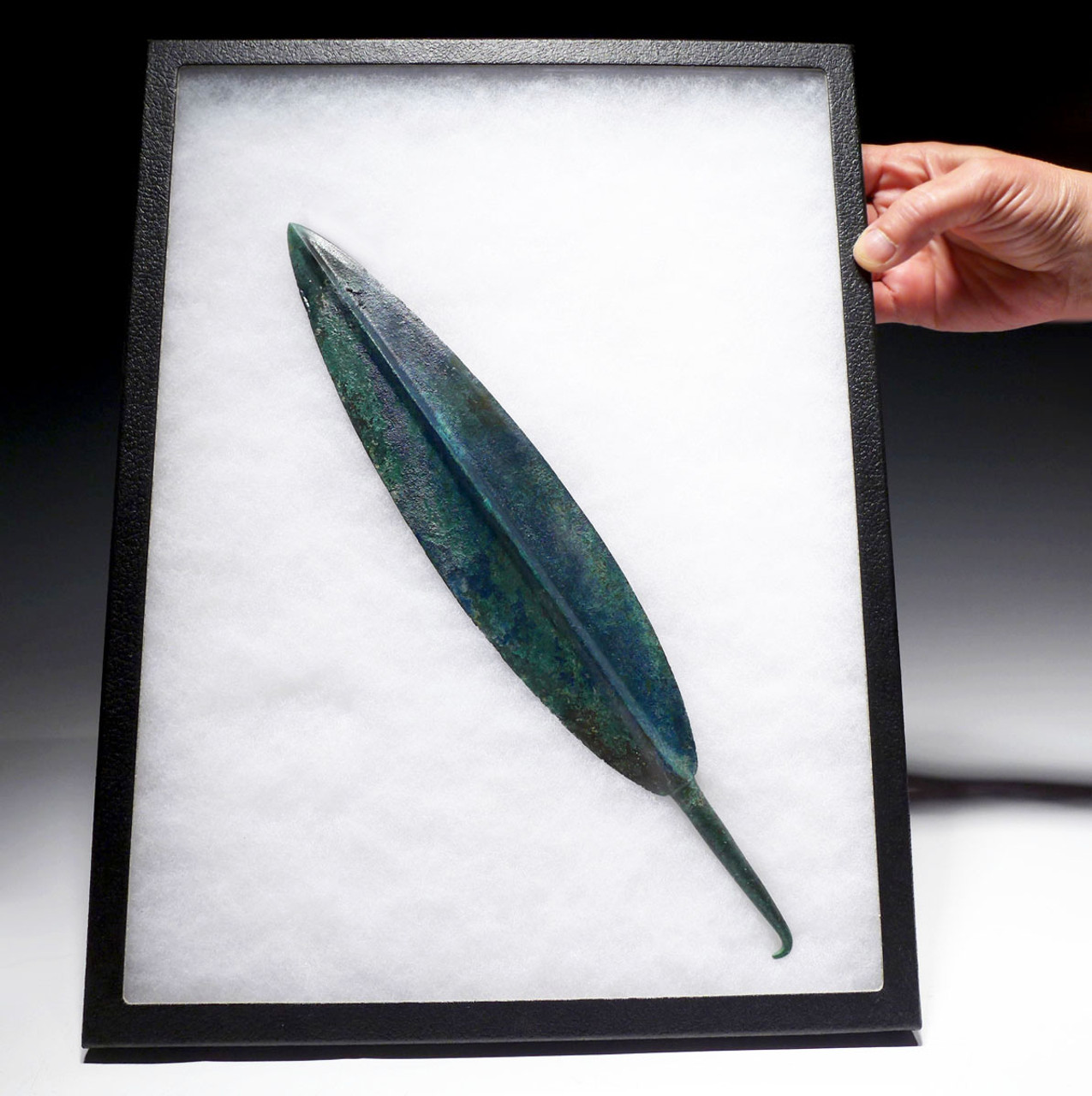Product Description
SEE MORE ANCIENT NEAR EASTERN ARTIFACTS
The ancient Sumerians, not the ancient Greeks, were the inventors of phalanx warfare, originating thousands of years before the dawn of Sparta. This is a VERY RARE and superbly preserved, MUSEUM-CLASS bronze phalanx pike spearhead from ancient Sumer of the Near East Bronze Age. This is the first time in 24 years we have offered any ancient Sumerian weaponry. The massive proportions, along with the most stunning preservation is further magnified by its remarkable patina of colorful blue Azurite and green Malachite mineral encrustations. Its heavy weight and broad cutting blade with a strong, armor-piercing tip, was not only highly effective mounted on a front-line phalanx pike spear, it was also meant to instill fear in enemy formations. Imagine a wall of these massive spearheads leading an unwavering advance from a hoard of armored soldiers!
The heavy tang would have been embedded in a groove in a large wooden pole. Traces of binding cord amazingly, have been preserved on the tang just below the base of the blade, as seen in the photos. The heavy blade with a thick central rib and solid bronze neck provided strength to keep the spearhead from bending during slow forced thrusting impact, and allowed a strong enough design for armor penetration.
As a true investment-class specimen, this is a piece that is impossible to improve on. The incredible aesthetics and weight make it such a pleasure to handle and admire!
This artifact has been professionally cleaned and conserved in our lab, being treated with a special sealer developed and formulated by us specifically for ancient metal preservation. The patina shows beautiful traits only found in authentic ancient weapons. It is a patina like this that the finest ancient bronzes are prized for and it is a patina like this that brings a premium in price and value of the specimen. There is no active bronze disease. Bronze disease can develop on ancient bronze that is not properly cleaned and conserved. It produces a corrosive powder that will literally eat away an artifact over time and destroy it.
WARNING: There is a STAGGERING number of fake bronze weapons on the market. Many being sold as "authentic" were never meant to deceive and were made as far back as 100 years ago as exact reproductions for museums to sell in their gift shops. Other examples are modern fabrications specifically intended to fool unwitting buyers. As fine quality intact, original specimens become more scarce, the techniques to fake these objects have become highly advanced. We have personally handled numerous well-done fakes with extremely convincing patinas. The degree to which the fakers have been able to replicate patina to disguise their work requires an expert examination by highly experienced individuals. It is common to find very reasonably priced weapons that are made up of part original and part modern components or wholly modern pieces displaying elaborate artificial patinas. All purchases should include a written guarantee of authenticity from the seller, with unconditional and lifetime return policies regarding such guarantee, such as we provide.
HISTORY
Warfare in ancient Sumer predominantly consisted of small-scale conflicts between nearby city-states. Sumerian armies consisted of bronze-armored soldiers armed with various weapons, including spears, swords and sickle-swords, engaging each other in phalanx-like formations. The ancient Sumerian army fielded a standard six-man-deep phalanx; the first line went into battle carrying large, rectangular shields, and the troops bore heavy pikes and battle axes.
Depictions of warfare are a common theme in Mesopotamian art. Usually the art, commissioned by the victors, would celebrate and glorify a military victory. Some notable examples are the Royal Standard of Ur and the Steele of the Vultures: the Royal Standard depicts soldiers, led by the king of Ur, marching over the corpses of their enemy, while others drag prisoners of war behind them; while the Steele of Vultures (image below) depicts the king of Lagash defeating the king of Umma, soldiers marching in a phalanx-like formation, and vultures carrying the severed heads of the soldiers from Umma, who had fallen in heaps in front of the soldiers from Lagash. Epigraphy and archaeological records show other depictions of warfare.

 US DOLLAR
US DOLLAR
 EURO
EURO
 AUSTRALIAN DOLLAR
AUSTRALIAN DOLLAR
 CANADIAN DOLLAR
CANADIAN DOLLAR
 POUND STERLING
POUND STERLING


























